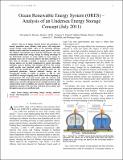| dc.contributor.author | Slocum, Alexander H. | |
| dc.contributor.author | Fennell, Gregory E. | |
| dc.contributor.author | Dundar, Gokhan | |
| dc.contributor.author | Hodder, Brian | |
| dc.contributor.author | Meredith, James D. C. | |
| dc.contributor.author | Sager, Monique A. | |
| dc.date.accessioned | 2013-05-23T19:20:01Z | |
| dc.date.available | 2013-05-23T19:20:01Z | |
| dc.date.issued | 2013-03 | |
| dc.date.submitted | 2012-10 | |
| dc.identifier.issn | 0018-9219 | |
| dc.identifier.other | INSPEC Accession Number: 13370104 | |
| dc.identifier.uri | http://hdl.handle.net/1721.1/78934 | |
| dc.description.abstract | Due to its higher capacity factor and proximity to densely populated areas, offshore wind power with integrated energy storage could satisfy > 20% of U.S. electricity demand. Similar results could also be obtained in many parts of the world. The offshore environment can be used for unobtrusive, safe, and economical utility-scale energy storage by taking advantage of the hydrostatic pressure at ocean depths to store energy by pumping water out of concrete spheres and later allowing it to flow back in through a turbine to generate electricity. The storage spheres are an ideal complement to energy harvesting machines, such as floating wind turbines (FWTs). The system could provide near-base-load-quality utility-scale renewable energy and do double duty as the anchoring point for the generation platforms. Analysis indicates that storage can be economically feasible at depths as shallow as 200 m, with cost per megawatt hour of storage dropping until 1500 m before beginning to trend upward. The sweet spot occurs when the concrete wall thickness to withstand the hydrostatic pressure provides enough ballast mass, and this will depend on the strength of used concrete and reinforcement. In addition, the required concrete would use significant amounts of fly ash from coal-fired power plants, and the spheres can serve as artificial reefs. | en_US |
| dc.description.sponsorship | Massachusetts Institute of Technology. Energy Initiative | en_US |
| dc.language.iso | en_US | |
| dc.publisher | Institute of Electrical and Electronics Engineers | en_US |
| dc.relation.isversionof | http://dx.doi.org/10.1109/JPROC.2013.2242411 | en_US |
| dc.rights | Creative Commons Attribution-Noncommercial-Share Alike 3.0 | en_US |
| dc.rights.uri | http://creativecommons.org/licenses/by-nc-sa/3.0/ | en_US |
| dc.source | Prof. Slocum via Angie Locknar | en_US |
| dc.title | Ocean Renewable Energy Storage (ORES) System: Analysis of an Undersea Energy Storage Concept | en_US |
| dc.type | Article | en_US |
| dc.identifier.citation | Slocum, Alexander H., Gregory E. Fennell, Gökhan Dundar, et al. 2013. "Ocean Renewable Energy Storage (ORES) System: Analysis of an Undersea Energy Storage Concept." Proceedings of the IEEE 101(4): 906–924. | en_US |
| dc.contributor.department | Massachusetts Institute of Technology. Department of Mechanical Engineering | en_US |
| dc.contributor.approver | Slocum, Alexander H. | en_US |
| dc.contributor.mitauthor | Slocum, Alexander H. | en_US |
| dc.contributor.mitauthor | Dundar, Gokhan | en_US |
| dc.contributor.mitauthor | Hodder, Brian | en_US |
| dc.contributor.mitauthor | Meredith, James D. C. | en_US |
| dc.relation.journal | Proceedings of the IEEE | en_US |
| dc.eprint.version | Author's final manuscript | en_US |
| dc.type.uri | http://purl.org/eprint/type/ConferencePaper | en_US |
| eprint.status | http://purl.org/eprint/status/NonPeerReviewed | en_US |
| dspace.orderedauthors | Slocum, A. H.; Fennell, G. E.; Dundar, G.; Hodder, B. G.; Meredith, J. D. C.; Sager, M. A. | en_US |
| dc.identifier.orcid | https://orcid.org/0000-0002-5048-4109 | |
| mit.license | OPEN_ACCESS_POLICY | en_US |
| mit.metadata.status | Complete | |
